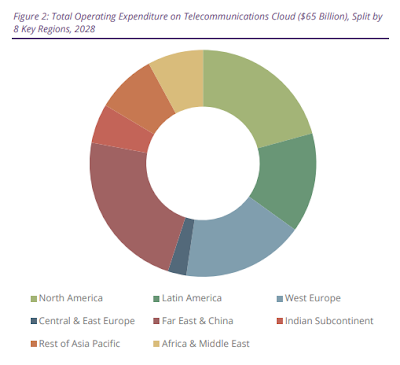The telecom sector is undertaking an update of its IT infrastructure. As demand for data continues to soar with the proliferation of 5G and new apps, network operators can’t rely on their legacy hardware and network architectures.
The process of “Cloudification” offers a path to reduce costs, improve efficiency and scalability, plus meet increasingly ambitious infrastructure sustainability goals.
According to the latest market study by Juniper Research, cloudification spending by telecom operators will see tremendous growth in the coming years, rising from $26.6 billion in 2024 to $64.9 billion by 2028 — that’s a 144 percent increase in just four years.
Telecom Cloud Apps Market Development
“Telecom networks are becoming more complex; requiring increasingly automated network management systems. However, operators must insulate mission-critical traffic when reducing power, to guarantee quality of service for enterprises,” said Alex Webb, research analyst at Juniper Research.
This multi-billion dollar investment underscores both the challenges network operators face in managing data growth and the opportunities that cloud technologies represent.
At the heart of the cloudification trend is the virtualization of network functions, replacing proprietary hardware appliances with virtualized software running on commodity servers and cloud infrastructure.
Foundational cloud computing platforms like IaaS, PaaS, and SaaS are enabling operators to access resources on-demand from public cloud providers while shifting more workloads to cost-effective cloud-native architectures.
The service-based architecture of 5G networks has been pivotal in accelerating cloudification by decoupling network planes and facilitating greater virtualization.
With 5G projected to grow from 2.2 billion connections in 2024 to 5.9 billion by 2028, cloudification strategies will be critical for operators to dynamically scale resources and efficiently manage soaring data growth, forecast to hit 5,347 exabytes by 2028.
Open-source projects like Kubernetes, Metal3, and Linux Nephio are also catalyzing cloudification by providing foundational cloud infrastructure orchestration and automation capabilities.
Juniper’s analysts expect Linux Nephio to play a particularly important role going forward in streamlining multi-cloud automation across telecom cloud deployments. The recently announced Nephio R2 with SDK tools tailored for telcos could accelerate the development of cloud-native 5G apps and network slicing.
While capacity expansion is a prime driver, cloudification further aligns with the telecom sector’s intensifying focus on sustainability and achieving net-zero carbon emissions.
According to the Juniper assessment, 92 percent of network operators now prioritize energy efficiency in their network transformation roadmaps, and nearly 40 percent have committed to net-zero targets to be validated against rigorous standards.
Cloud scalability combined with advanced automation will enhance operators’ ability to optimize energy usage in real-time by dynamically adjusting resources based on demand.
Outlook for Telco Cloud Applications Growth
The ongoing 5G evolution towards 5G-Advanced along with the eventual transition to 6G will bring increasingly demanding performance requirements around ultra-low latency, massive connectivity, and advanced sensing capabilities.
Cloud architectures and automation will be indispensable to cost-effectively operate and orchestrate these complex future networks.
Private 5G networks tailored for enterprise and industrial environments represent a significant new revenue opportunity for operators. Cloud-based deployment models could speed private 5G rollouts by reducing infrastructure costs while enabling on-demand scalability.
Hyperscale public cloud providers are increasingly collaborating with network operators, with AWS, Microsoft, and Google making strategic investments and product integrations to capture a share of the telco cloud market.
Looking ahead, deeper partnerships could accelerate cloudification by bundling public cloud resources.
As data demands intensify and sustainability mandates tighten, the telecommunications industry will continue its cloudification journey — virtualizing network functions, automating operations, and leveraging public cloud infrastructure and services.
That said, I believe the impressive spending forecasts reflect that cloudification is no longer an option, but an imperative for modern networks to ensure both operational efficiency and a reduced environmental footprint.
